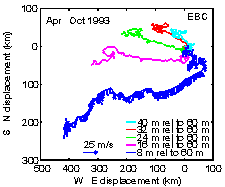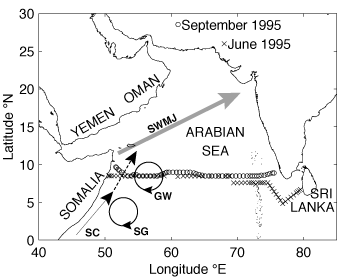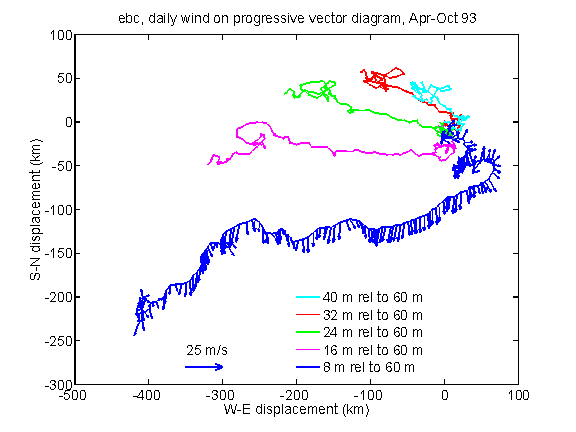
 |
Wind-Driven Circulation and the Ekman Balance |
Teresa K. Chereskin |
The atmosphere exchanges mass, energy, and momentum with the deep ocean through forced motions in the upper few hundred meters. The resulting ocean circulation redistributes these properties and thus plays an important role in determining global climate. The dynamics of energy and momentum transfer from wind to water, the formation of the surface mixed layer, and the transfer of energy and momentum through the surface mixed layer to the deep ocean are still not well understood. Quantitative testing of theories has proven very difficult, due in part to the technical challenge of making measurements in the harsh surface environment. Confirmation of one of the oldest theories of the wind-driven circulation (due to Ekman), and one on which ocean circulation models are based, eluded oceanographers until the last decade, although the success of Ekman's theory in predicting the dominant features of the circulation has long provided indirect confirmation (Chereskin and Price, 2001). One of the technological breakthroughs in direct confirmation of the Ekman balance was the ADCP: the shipboard ADCP in providing basin-integrals of Ekman transport and the moored ADCP in providing highly resolved profiles of current in the rugged surface regime.
The Ekman transport calculation that Dean Roemmich and I made from our transect at 11°N in the Atlantic Ocean was the first quantitative estimate of basin-integrated Ekman transport based on measured velocities in the upper ocean (Chereskin and Roemmich, 1991). Our estimate agreed with that predicted by Ekman theory from wind. However, the measured flow revealed the vertical and horizontal structure of the wind-driven currents in addition to the net transport. We found that the wind-driven currents extended below the mixed layer to the top of the thermocline, and thus the Ekman heat transport was significantly less than that estimated assuming a constant mixed layer temperature and the net volume transport predicted by the wind. The deep penetration of the wind-driven flow at low latitude (to the top of the pycnocline) has now been observed from WOCE surveys in all three major oceans (Chereskin and Price, 2001). This deep penetration has its largest influence on the Ekman heat and salt transports in the Arabian Sea, despite being the smallest of the basins, because of the strong monsoon forcing (Chereskin et al., 1997).

Figure 1: Ship tracks and
hydrographic station locations. Shown schematically, the southwest
monsoon jet (SWMJ), the Somali current (SC), the Great Whirl (GW), and
the Southern Gyre (SG). (From Chereskin et al., 1997)
The WOCE lines sampled the Arabian Sea at the onset (June) and the wane (September) of the 1995 monsoon. The Arabian Sea undergoes a dramatic seasonal cycle due to the monsoons. As a result, the wind-driven Ekman transport, the western boundary current (Somali Current), and the interior Arabian gyre all reverse seasonally. There are many interesting phenomena associated with the monsoons, but one of the most intriguing is the phenomenon of Arabian Sea cooling during the summertime southwest monsoon. At a time when the net surface heat flux is at a maximum and is directed into the ocean, the Arabian Sea experiences a rapid heat loss due primarily to the export of heat via the strong southeastward Ekman transport. Since the Ekman transport is large, carries the warmest water, and reverses seasonally, it can potentially reverse the sign of the net seasonal heat transport of the Arabian Sea. Analysis of global eddy-resolving models suggest that the annual cycle of heat flux in the northern Indian Ocean is dominated by the Ekman temperature flux in the Arabian Sea. The Ekman temperature flux is sensitive to assumptions about the depth of penetration of the wind-driven flow, and therefore the Ekman depth as well as the Ekman transport are important issues for the meridional overturning circulation of the Indian Ocean. The Ekman layer temperature calculated from the 8°30'N section across the Arabian Sea in September 1995 was 1.1°C colder than surface values (Chereskin, et al., 2002).
The best statistical test of the Ekman balance comes from long time series. The first such test with a moored ADCP (Chereskin, 1995) found remarkable agreement between theory and observations (to within 3%). The progressive vector diagram below shows the Ekman spiral: a net displacement to the right of the wind, and a clockwise spiral of the currents with depth. The Ekman spiral stands out clearly in these measurements for 2 reasons: first, the remarkably steady wind direction, and the excellent vertical resolution from the ADCP.

Figure 2: Progressive vector diagram, using daily averaged currents relative to the flow at 48 m, at a subset of depths from a moored ADCP at 37.1°N, 127.6°W
in the California Current, deployed as part of the Eastern Boundary Currents experiment. Daily averaged wind vectors are plotted at midnight UT along the 8-m
relative to 48-m displacement curve. Wind velocity scale is shown at bottom left. (From
Chereskin, 1995)
Chereskin, T. K., and D. Roemmich, 1991: A comparison of measured and wind-derived Ekman transport at 11°N in the Atlantic ocean. J. Phys. Oc., 21, 869-878. Abstract
Chereskin, T. K., 1995: Evidence for an Ekman balance in the California Current. J. Geophys. Res., 100, 12727-12748. Abstract
Chereskin, T. K., W. D. Wilson, H. L. Bryden, A. Ffield, and J. Morrison, 1997: Observations of the Ekman balance at 8°30'N in the Arabian Sea during the southwest monsoon. Geophys. Res. Lett., 24, 2541-2544. Abstract
Chereskin, T. K., and J. F. Price, 2001: Ekman transport and pumping. Encyclopedia of Ocean Sciences, 2 (D-H),809-815.Abstract
Chereskin, T. K., W. D. Wilson, and L. M. Beal, 2002: The Ekman temperature and salt fluxes at 8°30' in the Arabian Sea during the 1995 southwest monsoon. Deep-Sea Res. II, 49, 1211-1230.